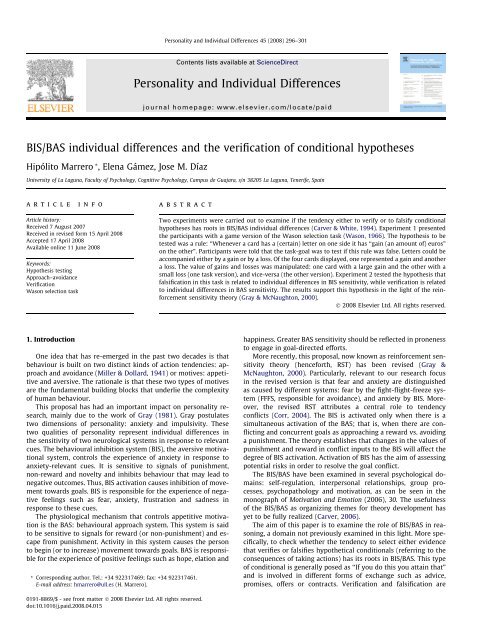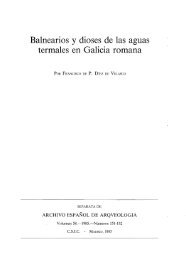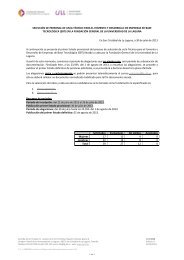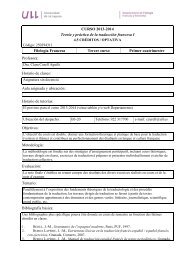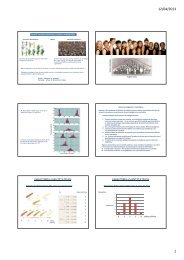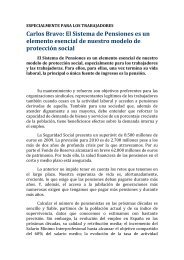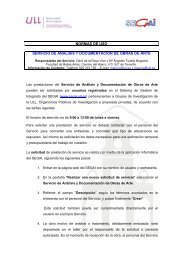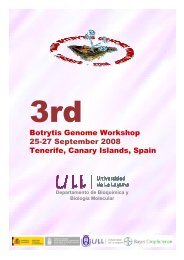BIS/BAS individual differences and the verification of conditional ...
BIS/BAS individual differences and the verification of conditional ...
BIS/BAS individual differences and the verification of conditional ...
You also want an ePaper? Increase the reach of your titles
YUMPU automatically turns print PDFs into web optimized ePapers that Google loves.
Personality <strong>and</strong> Individual Differences 45 (2008) 296–301Contents lists available at ScienceDirectPersonality <strong>and</strong> Individual Differencesjournal homepage: www.elsevier.com/locate/paid<strong>BIS</strong>/<strong>BAS</strong> <strong>individual</strong> <strong>differences</strong> <strong>and</strong> <strong>the</strong> <strong>verification</strong> <strong>of</strong> <strong>conditional</strong> hypo<strong>the</strong>sesHipólito Marrero * , Elena Gámez, Jose M. DíazUniversity <strong>of</strong> La Laguna, Faculty <strong>of</strong> Psychology, Cognitive Psychology, Campus de Guajara, s/n 38205 La Laguna, Tenerife, SpainarticleinfoabstractArticle history:Received 7 August 2007Received in revised form 15 April 2008Accepted 17 April 2008Available online 11 June 2008Keywords:Hypo<strong>the</strong>sis testingApproach–avoidanceVerificationWason selection taskTwo experiments were carried out to examine if <strong>the</strong> tendency ei<strong>the</strong>r to verify or to falsify <strong>conditional</strong>hypo<strong>the</strong>ses has roots in <strong>BIS</strong>/<strong>BAS</strong> <strong>individual</strong> <strong>differences</strong> (Carver & White, 1994). Experiment 1 presented<strong>the</strong> participants with a game version <strong>of</strong> <strong>the</strong> Wason selection task (Wason, 1966). The hypo<strong>the</strong>sis to betested was a rule: ‘‘Whenever a card has a (certain) letter on one side it has ‘‘gain (an amount <strong>of</strong>) euros”on <strong>the</strong> o<strong>the</strong>r”. Participants were told that <strong>the</strong> task-goal was to test if this rule was false. Letters could beaccompanied ei<strong>the</strong>r by a gain or by a loss. Of <strong>the</strong> four cards displayed, one represented a gain <strong>and</strong> ano<strong>the</strong>ra loss. The value <strong>of</strong> gains <strong>and</strong> losses was manipulated: one card with a large gain <strong>and</strong> <strong>the</strong> o<strong>the</strong>r with asmall loss (one task version), <strong>and</strong> vice-versa (<strong>the</strong> o<strong>the</strong>r version). Experiment 2 tested <strong>the</strong> hypo<strong>the</strong>sis thatfalsification in this task is related to <strong>individual</strong> <strong>differences</strong> in <strong>BIS</strong> sensitivity, while <strong>verification</strong> is relatedto <strong>individual</strong> <strong>differences</strong> in <strong>BAS</strong> sensitivity. The results support this hypo<strong>the</strong>sis in <strong>the</strong> light <strong>of</strong> <strong>the</strong> reinforcementsensitivity <strong>the</strong>ory (Gray & McNaughton, 2000).Ó 2008 Elsevier Ltd. All rights reserved.1. IntroductionOne idea that has re-emerged in <strong>the</strong> past two decades is thatbehaviour is built on two distinct kinds <strong>of</strong> action tendencies: approach<strong>and</strong> avoidance (Miller & Dollard, 1941) or motives: appetitive<strong>and</strong> aversive. The rationale is that <strong>the</strong>se two types <strong>of</strong> motivesare <strong>the</strong> fundamental building blocks that underlie <strong>the</strong> complexity<strong>of</strong> human behaviour.This proposal has had an important impact on personality research,mainly due to <strong>the</strong> work <strong>of</strong> Gray (1981). Gray postulatestwo dimensions <strong>of</strong> personality: anxiety <strong>and</strong> impulsivity. Thesetwo qualities <strong>of</strong> personality represent <strong>individual</strong> <strong>differences</strong> in<strong>the</strong> sensitivity <strong>of</strong> two neurological systems in response to relevantcues. The behavioural inhibition system (<strong>BIS</strong>), <strong>the</strong> aversive motivationalsystem, controls <strong>the</strong> experience <strong>of</strong> anxiety in response toanxiety-relevant cues. It is sensitive to signals <strong>of</strong> punishment,non-reward <strong>and</strong> novelty <strong>and</strong> inhibits behaviour that may lead tonegative outcomes. Thus, <strong>BIS</strong> activation causes inhibition <strong>of</strong> movementtowards goals. <strong>BIS</strong> is responsible for <strong>the</strong> experience <strong>of</strong> negativefeelings such as fear, anxiety, frustration <strong>and</strong> sadness inresponse to <strong>the</strong>se cues.The physiological mechanism that controls appetitive motivationis <strong>the</strong> <strong>BAS</strong>: behavioural approach system. This system is saidto be sensitive to signals for reward (or non-punishment) <strong>and</strong> escapefrom punishment. Activity in this system causes <strong>the</strong> personto begin (or to increase) movement towards goals. <strong>BAS</strong> is responsiblefor <strong>the</strong> experience <strong>of</strong> positive feelings such as hope, elation <strong>and</strong>* Corresponding author. Tel.: +34 922317469; fax: +34 922317461.E-mail address: hmarrero@ull.es (H. Marrero).happiness. Greater <strong>BAS</strong> sensitivity should be reflected in pronenessto engage in goal-directed efforts.More recently, this proposal, now known as reinforcement sensitivity<strong>the</strong>ory (henceforth, RST) has been revised (Gray &McNaughton, 2000). Particularly, relevant to our research focusin <strong>the</strong> revised version is that fear <strong>and</strong> anxiety are distinguishedas caused by different systems: fear by <strong>the</strong> fight-flight-freeze system(FFFS, responsible for avoidance), <strong>and</strong> anxiety by <strong>BIS</strong>. Moreover,<strong>the</strong> revised RST attributes a central role to tendencyconflicts (Corr, 2004). The <strong>BIS</strong> is activated only when <strong>the</strong>re is asimultaneous activation <strong>of</strong> <strong>the</strong> <strong>BAS</strong>; that is, when <strong>the</strong>re are conflicting<strong>and</strong> concurrent goals as approaching a reward vs. avoidinga punishment. The <strong>the</strong>ory establishes that changes in <strong>the</strong> values <strong>of</strong>punishment <strong>and</strong> reward in conflict inputs to <strong>the</strong> <strong>BIS</strong> will affect <strong>the</strong>degree <strong>of</strong> <strong>BIS</strong> activation. Activation <strong>of</strong> <strong>BIS</strong> has <strong>the</strong> aim <strong>of</strong> assessingpotential risks in order to resolve <strong>the</strong> goal conflict.The <strong>BIS</strong>/<strong>BAS</strong> have been examined in several psychological domains:self-regulation, interpersonal relationships, group processes,psychopathology <strong>and</strong> motivation, as can be seen in <strong>the</strong>monograph <strong>of</strong> Motivation <strong>and</strong> Emotion (2006), 30. The usefulness<strong>of</strong> <strong>the</strong> <strong>BIS</strong>/<strong>BAS</strong> as organizing <strong>the</strong>mes for <strong>the</strong>ory development hasyet to be fully realized (Carver, 2006).The aim <strong>of</strong> this paper is to examine <strong>the</strong> role <strong>of</strong> <strong>BIS</strong>/<strong>BAS</strong> in reasoning,a domain not previously examined in this light. More specifically,to check whe<strong>the</strong>r <strong>the</strong> tendency to select ei<strong>the</strong>r evidencethat verifies or falsifies hypo<strong>the</strong>tical <strong>conditional</strong>s (referring to <strong>the</strong>consequences <strong>of</strong> taking actions) has its roots in <strong>BIS</strong>/<strong>BAS</strong>. This type<strong>of</strong> <strong>conditional</strong> is generally posed as ‘‘If you do this you attain that”<strong>and</strong> is involved in different forms <strong>of</strong> exchange such as advice,promises, <strong>of</strong>fers or contracts. Verification <strong>and</strong> falsification are0191-8869/$ - see front matter Ó 2008 Elsevier Ltd. All rights reserved.doi:10.1016/j.paid.2008.04.015
H. Marrero et al. / Personality <strong>and</strong> Individual Differences 45 (2008) 296–301 297central phenomena for hypo<strong>the</strong>sis-testing research. Verificationhas been shown to be a general bias: people tend to look for evidencethat verifies a previous hypo<strong>the</strong>sis (see Nickerson, 1998).However, falsification is preferred if <strong>the</strong> (hypo<strong>the</strong>tical) <strong>conditional</strong>action ? result refers to social contracts (Cosmides, 1989). Moreover,people are motivated to reject (<strong>and</strong> to falsify) threateningpropositions (Dawson, Gilovich, & Regan, 2002).How could <strong>BIS</strong>/<strong>BAS</strong> affect reasoning in <strong>the</strong> ambit <strong>of</strong> searchingfor evidence to test hypo<strong>the</strong>tical <strong>conditional</strong>s? One possible wayis by biasing <strong>individual</strong>s towards selecting ei<strong>the</strong>r evidence for falsifyingor verifying action ? result <strong>conditional</strong>s. Take <strong>the</strong> example<strong>of</strong> advice; someone tells you that by investing in <strong>the</strong> shares <strong>of</strong>company C, you gain money. This comment constitutes a hypo<strong>the</strong>ticalaction ? result <strong>conditional</strong> (If someone invests in <strong>the</strong>shares <strong>of</strong> company C <strong>the</strong>n he/she gains money) <strong>and</strong> it could be inyour interest to find evidence to check this hypo<strong>the</strong>sis. As aforementioned,<strong>the</strong> <strong>BAS</strong> is sensitive to signals for reward, <strong>and</strong> socauses approach towards behaviour that may lead to rewardingoutcomes. There could be signals <strong>of</strong> a reward following <strong>the</strong> action<strong>of</strong> investing. For example, you are informed that <strong>the</strong> companyis trustworthy in a growing economic sector. In that case,<strong>BAS</strong> leads you to attempt to check <strong>the</strong> sequence action ? reward.That is, to verify <strong>the</strong> action ? result <strong>conditional</strong> by beingsensitive to (or actively looking for) evidence <strong>of</strong>: (a) Personswho have invested in shares <strong>of</strong> company C (Have <strong>the</strong>y gainedmoney?); <strong>and</strong> (b) persons who have gained money (Have <strong>the</strong>yinvested in company C?).Conversely, <strong>the</strong> <strong>BIS</strong> is sensitive to signals <strong>of</strong> punishment (ornon-reward), <strong>and</strong> so causes inhibition towards behaviour thatmay lead to negative outcomes. There could be signals <strong>of</strong> punishmentfollowing <strong>the</strong> action <strong>of</strong> investing; for example, you are informedthat <strong>the</strong> company is untrustworthy. In this case, <strong>BIS</strong> leadsyou to try to check <strong>the</strong> sequence action ? punishment. That is, t<strong>of</strong>alsify <strong>the</strong> action ? result <strong>conditional</strong> by being sensitive to evidence<strong>of</strong>: (a) Persons who have invested in shares <strong>of</strong> company C(Have <strong>the</strong>y lost money?); <strong>and</strong> (b) Persons who have lost money(Have <strong>the</strong>y invested in shares <strong>of</strong> company C?).The bias towards <strong>verification</strong> (in contrast to <strong>the</strong> greater difficulty<strong>of</strong> falsification) has received several explanations. From acognitive perspective, Evans (1989) attributed this to <strong>the</strong> facilityto represent positive instances <strong>of</strong> a certain proposition in contrastto <strong>the</strong> alternative negative ones. From a motivational perspective,Dawson et al. (2002) made <strong>the</strong> proposal that people tend to accept(<strong>and</strong> so to verify) agreeable or neutral propositions, while <strong>the</strong>y aremotivated to reject (<strong>and</strong> so to falsify) disagreeable <strong>and</strong> threateningpropositions. From <strong>the</strong> <strong>BIS</strong>/<strong>BAS</strong> perspective, <strong>the</strong> occurrence <strong>of</strong><strong>verification</strong> versus falsification depends on <strong>the</strong> reward <strong>and</strong> punishmentinvolved in accepting <strong>the</strong> proposition. As previously shown,<strong>the</strong> <strong>conditional</strong> proposition: If someone invests in <strong>the</strong> shares <strong>of</strong>company C <strong>the</strong>n he/she gains money would be verified if <strong>the</strong>probability (<strong>and</strong> value) <strong>of</strong> <strong>the</strong> reward (‘‘gaining money”) is high.In contrast, it would be falsified if what is high is <strong>the</strong> alternativepunishment (‘‘losing money”). In contrast to <strong>the</strong> motivational<strong>and</strong> cognitive approaches, nei<strong>the</strong>r <strong>the</strong> agreeability <strong>of</strong> <strong>the</strong> propositionnor <strong>the</strong> cognitive scenario has changed when <strong>verification</strong> orfalsification occur.The Wason selection task (Wason, 1966) is a useful tool in research<strong>of</strong> <strong>the</strong> cognitive processes involved in verifying/falsifying<strong>conditional</strong> rules or hypo<strong>the</strong>ses by checking partial evidence ei<strong>the</strong>rin epistemic (Evans, 1998) or social contexts (Cosmides, 1989).The original task is a paper-<strong>and</strong>-pencil problem that invitessubjects to check whe<strong>the</strong>r a hypo<strong>the</strong>tical <strong>conditional</strong> rule <strong>of</strong> <strong>the</strong>type ‘‘if p <strong>the</strong>n q” is true or false as follows (see Fig. 1).The usual selection, about 45% <strong>of</strong> <strong>the</strong> time, is that <strong>of</strong> cards ‘‘A”(<strong>the</strong> ‘‘p” card) <strong>and</strong> ‘‘4” (<strong>the</strong> ‘‘q” card), which is a confirmatory selection(see Nickerson, 1998). The falsifying selection <strong>of</strong> turning overcard ‘‘A” (<strong>the</strong> ‘‘p” card: to see if it has a seven on <strong>the</strong> o<strong>the</strong>r side) <strong>and</strong>card ‘‘seven” (<strong>the</strong> ‘‘not-q” card: to see if it has an A on <strong>the</strong> o<strong>the</strong>rside) is infrequent (less than 10%).It has been demonstrated that <strong>verification</strong> <strong>and</strong> falsificationstrategies in this task are induced by <strong>the</strong> type <strong>of</strong> content, <strong>the</strong> taskcontext <strong>and</strong> instructions (see Evans, 1998). However, as far as weknow, <strong>the</strong> role <strong>of</strong> <strong>BIS</strong>/<strong>BAS</strong> has not been examined.Here we adapt <strong>the</strong> Wason selection task <strong>and</strong> directly focus onexamining <strong>the</strong> role <strong>of</strong> <strong>BIS</strong>/<strong>BAS</strong> in orientating <strong>individual</strong>s towardsei<strong>the</strong>r <strong>the</strong> falsification or <strong>verification</strong> <strong>of</strong> contextual <strong>and</strong> hypo<strong>the</strong>ticalaction ? result <strong>conditional</strong>s.2. Study 1Fig. 1. The original Wason selection task.We presented <strong>the</strong> participants with a game version <strong>of</strong> <strong>the</strong> Selectiontask elaborated by <strong>the</strong> authors. The hypo<strong>the</strong>sis to be checkedwas a rule: ‘‘Whenever a card has a (certain) letter on one side ithas ‘‘gain (an amount <strong>of</strong>) euros” on <strong>the</strong> o<strong>the</strong>r”. Letters could beaccompanied ei<strong>the</strong>r by a gain or by a loss. Of <strong>the</strong> four cards displayed,one represented a gain <strong>and</strong> <strong>the</strong> o<strong>the</strong>r a loss. The value <strong>of</strong>gains <strong>and</strong> losses was manipulated: one card with a large gain<strong>and</strong> <strong>the</strong> o<strong>the</strong>r with a small loss in one task version, <strong>and</strong> vice-versa,one card with a small gain <strong>and</strong> <strong>the</strong> o<strong>the</strong>r with a large loss, in <strong>the</strong>o<strong>the</strong>r version. Participants were told that <strong>the</strong> task-goal was tocheck in a free-cost test whe<strong>the</strong>r <strong>the</strong> rule was false in order toavoid <strong>the</strong> loss (see Appendix A).As aforementioned, <strong>the</strong> revised RST attributes a central role totendency conflicts. Here <strong>the</strong>re is a conflict between attaining a reward(<strong>the</strong> gain) <strong>and</strong> avoiding a punishment (<strong>the</strong> loss). Accordingto Corr (2002), <strong>the</strong> conflict between <strong>the</strong> reward <strong>and</strong> punishmentis resolved by <strong>the</strong> decision mechanism depending on which inputto this mechanism is stronger. Therefore, activation <strong>of</strong> <strong>BAS</strong> wouldpredominate when a great reward is involved. Conversely, activation<strong>of</strong> <strong>BIS</strong> would predominate if a great punishment (in contrastto a small reward) is involved. Therefore, our predictions werethat participants will tend to verify <strong>the</strong> <strong>conditional</strong> rule in <strong>the</strong>condition ‘‘large gain/ small loss” <strong>and</strong> solve <strong>the</strong> task by concludingthat <strong>the</strong> rule is false if it is not true. In this task version, <strong>BAS</strong>would lead subjects to check <strong>the</strong> sequence action ? reward (<strong>the</strong>large gain), that is, to check if <strong>the</strong> letter A is followed by <strong>the</strong> gain<strong>and</strong> <strong>the</strong> gain card is preceded by <strong>the</strong> letter A. In contrast, we predictthat subjects will tend to falsify <strong>the</strong> rule in <strong>the</strong> condition‘‘small gain/large loss” <strong>and</strong> solve <strong>the</strong> task by directly consideringif <strong>the</strong> rule is false. In this version, <strong>BIS</strong> leads subjects to check<strong>the</strong> sequence action ? punishment (<strong>the</strong> large loss), that is, to checkif <strong>the</strong> letter A is followed by <strong>the</strong> loss <strong>and</strong> <strong>the</strong> loss card is precededby <strong>the</strong> letter A.
298 H. Marrero et al. / Personality <strong>and</strong> Individual Differences 45 (2008) 296–3012.1. Method2.1.1. ParticipantsOne hundred twenty-seven students from <strong>the</strong> University <strong>of</strong> LaLaguna participated in this experiment in exchange for coursecredit. Their ages ranged from 18 to 27. Thirty-seven were male.2.1.2. Design <strong>and</strong> procedureThe design had one between-subject factor, <strong>the</strong> gain/loss valuedisplayed in <strong>the</strong> cards with two conditions: Large gain/small loss<strong>and</strong> small gain/large loss. Two dependent variables were used.One was ‘‘Loss card selection”, <strong>the</strong> result <strong>of</strong> adding <strong>the</strong> followingselections: letter A <strong>and</strong> <strong>the</strong> loss card, letter Y <strong>and</strong> <strong>the</strong> loss card,<strong>and</strong> <strong>the</strong> loss card alone. The o<strong>the</strong>r was ‘‘Gain card selection”, <strong>the</strong> result<strong>of</strong> adding <strong>the</strong> selections: letter A <strong>and</strong> <strong>the</strong> gain card, letter Y <strong>and</strong><strong>the</strong> gain card, <strong>and</strong> <strong>the</strong> gain card alone.Seventy subjects were assigned to <strong>the</strong> ‘‘small gain/large loss”<strong>and</strong> 57 subjects to <strong>the</strong> ‘‘large gain/small loss” conditions. Thetwo task versions were r<strong>and</strong>omly given out to <strong>the</strong> students duringregular class without a time limit in a quiet environment.The proportion <strong>of</strong> male participants was similar in <strong>the</strong>conditions.2.2. ResultsAs expected, participants selected <strong>the</strong> gain card (49%) morethan <strong>the</strong> loss card (26%) significantly in <strong>the</strong> condition large gain/small loss, v 2 (1) = 6.32, p < .05. In contrast, <strong>the</strong> gain <strong>and</strong> loss cardswere equally selected in <strong>the</strong> condition small gain/large loss (42%).If we consider <strong>the</strong> gain card selection, <strong>the</strong>re was no significanteffect between <strong>the</strong> large gain/small loss (49%) <strong>and</strong> <strong>the</strong> smallgain/large loss (42%) conditions, v 2 (1) = 0.63, p > .20. In <strong>the</strong> case<strong>of</strong> <strong>the</strong> loss card selection, participants selected <strong>the</strong> loss card morein <strong>the</strong> condition small gain/large loss (42%) than in <strong>the</strong> conditionlarge gain/small loss (26%), in a marginally significant way, v 2(1) = 3.39, p < .10.It was relevant that participants who selected <strong>the</strong> ‘‘gain card”tended to justify <strong>the</strong>ir decision as aimed ei<strong>the</strong>r at confirming ornot <strong>the</strong> rule; for example: ‘‘I selected <strong>the</strong> cards A <strong>and</strong> 100 € gain becauseon <strong>the</strong> o<strong>the</strong>r side <strong>of</strong> <strong>the</strong> card A you can find ei<strong>the</strong>r 100 € gainor 1 € loss. Likewise, on <strong>the</strong> o<strong>the</strong>r side <strong>of</strong> <strong>the</strong> card 100 € gain youcan find <strong>the</strong> letter A or ano<strong>the</strong>r letter.” In contrast, participantswho selected <strong>the</strong> loss card tended to justify <strong>the</strong>ir decision as aimedat directly falsifying <strong>the</strong> rule; for example... ‘‘I selected card A becauseI have to know if on <strong>the</strong> o<strong>the</strong>r side <strong>of</strong> this card <strong>the</strong>re is a 100 €loss, <strong>and</strong> card 100 € loss because if <strong>the</strong> letter A is on <strong>the</strong> o<strong>the</strong>r side, Iwill not play, I’ll pass.”These results give some support to our main predictions.Participants tended to verify <strong>the</strong> <strong>conditional</strong> rule by selecting <strong>the</strong>gain card if <strong>the</strong>re was a large gain. Conversely, participants tendedto falsify <strong>the</strong> <strong>conditional</strong> rule by selecting <strong>the</strong> loss card if <strong>the</strong>re wasa large loss in contrast to a small gain.However, <strong>the</strong> absence <strong>of</strong> more robust statistical effects in <strong>the</strong>type <strong>of</strong> selection made in <strong>the</strong> two experimental conditions suggeststhat <strong>the</strong>re could have been an influence <strong>of</strong> <strong>individual</strong>variability. Participants could have differed in <strong>the</strong>ir sensitivitiesto reward (gain) <strong>and</strong> to punishment (loss), <strong>and</strong> this variabilitycould have weakened <strong>the</strong> experimental effects. The aim <strong>of</strong> Experiment2 was to examine <strong>the</strong> role <strong>of</strong> <strong>individual</strong> <strong>differences</strong> in <strong>BIS</strong>/<strong>BAS</strong>sensitivities in <strong>the</strong> card selection.3. Study 2The revised RST establishes that changes in <strong>the</strong> values <strong>of</strong>punishment <strong>and</strong> reward in conflict inputs to <strong>the</strong> <strong>BIS</strong> will affect<strong>the</strong> degree <strong>of</strong> <strong>BIS</strong> activation. Moreover, both reward <strong>and</strong> punishmentsensitivities will determine whe<strong>the</strong>r a conflict is detected<strong>and</strong> to what extent (Corr, 2004). Thus, we predicted that high<strong>BAS</strong> subjects will tend to verify <strong>the</strong> <strong>conditional</strong> rule by selecting<strong>the</strong> gain card in <strong>the</strong> condition ‘‘large gain/small loss”. As <strong>the</strong>y willbe sensitive to <strong>the</strong> greater value <strong>of</strong> reward, <strong>the</strong>y will tend not to detect<strong>the</strong> conflict <strong>and</strong> will check <strong>the</strong> sequence letter A ? gain card,that is, <strong>the</strong> sequence action ? reward. In contrast, high <strong>BIS</strong> subjectswill tend to falsify <strong>the</strong> <strong>conditional</strong> rule by selecting <strong>the</strong> loss card in<strong>the</strong> condition ‘‘small gain/large loss”. As <strong>the</strong>y will be sensitive to<strong>the</strong> greater value <strong>of</strong> punishment, <strong>the</strong>y will tend to detect <strong>the</strong> conflict<strong>and</strong> will check <strong>the</strong> sequence letter A ? loss card, that is,action ? punishment.Also relevant to our research is to examine whe<strong>the</strong>r punishment<strong>and</strong> reward sensitivities act as separable or joint subsystems,as <strong>the</strong> precise pattern <strong>of</strong> personality effects ishypo<strong>the</strong>sised to depend upon this (Corr, 2002). If <strong>the</strong>y act asseparable, <strong>BIS</strong> facilitates <strong>BIS</strong>-mediating conducts <strong>and</strong> <strong>BAS</strong> facilitates<strong>BAS</strong>-mediating conducts <strong>and</strong> mutual inhibition occurs. Incontrast, if <strong>the</strong>y act as joint subsystems, antagonism could beexpected with <strong>BIS</strong> impairing <strong>BAS</strong> mediated behaviour, <strong>and</strong> <strong>BAS</strong>impairing <strong>BIS</strong> mediated behaviour. Situations that contain mixedreward <strong>and</strong> punishment cues are hypo<strong>the</strong>sised to facilitate jointsubsystem activity. As <strong>the</strong>re are mixed cues <strong>of</strong> reward <strong>and</strong> punishmentin <strong>the</strong> game task, we adopt <strong>the</strong> joint subsystem hypo<strong>the</strong>sis.This predicts that appetitive (verifying) responses in <strong>the</strong>game task should be highest in <strong>individual</strong>s high in <strong>BAS</strong> but lowin <strong>BIS</strong>. Conversely, aversive (falsifying) responses should be highestin <strong>individual</strong>s high in <strong>BIS</strong> but low in <strong>BAS</strong>.3.1. Method3.1.1. ParticipantsOne hundred thirty-nine students from <strong>the</strong> University <strong>of</strong> La Laguna.Ages ranged from 18 to 29. Thirty-nine were males.3.1.2. Measures<strong>BIS</strong>/<strong>BAS</strong>. There are different <strong>BIS</strong>/<strong>BAS</strong> measures (Carver & White,1994; Caseras, Ávila, & Torrubia, 2003). We use <strong>the</strong> Carver <strong>and</strong>White scales that have been reported as useful in several studies(see Carver, 2006). The scales are a 20-item, four-point Likert-typemeasure composed <strong>of</strong> <strong>the</strong> following four subscales: <strong>BIS</strong>, withitems that reflect concern <strong>and</strong> fear about <strong>the</strong> possibility <strong>of</strong> a badoccurrence, or sensitivity to occurrence, <strong>BAS</strong>-reward responsiveness(<strong>BAS</strong>-RR) items reflect responsiveness to reward, <strong>BAS</strong>-drive(<strong>BAS</strong>-D) relates to <strong>the</strong> tendency to act quickly <strong>and</strong> strongly in pursuit<strong>of</strong> appetitive goals, <strong>and</strong> <strong>BAS</strong>-fun seeking (<strong>BAS</strong>-FS) refers to <strong>the</strong>tendency to seek out new potentially rewarding experiences.Respondents are asked to rate <strong>the</strong> extent <strong>of</strong> <strong>the</strong>ir agreement, from1 (strongly disagree) to4(strongly agree). Internal consistencies <strong>of</strong><strong>the</strong> scales ranged from good to excellent, <strong>and</strong> test–retest reliability,convergent <strong>and</strong> divergent as well as factorial validity weresatisfactory in <strong>the</strong> studies <strong>of</strong> Carver <strong>and</strong> White. Fur<strong>the</strong>r researchhas confirmed <strong>the</strong>ir st<strong>and</strong>ard as <strong>BIS</strong>/<strong>BAS</strong> measures (Carver,2006; Caseras, Ávila, & Torrubia, 2003). In <strong>the</strong> current study, <strong>the</strong>sample had alpha values <strong>BIS</strong>: .81, <strong>BAS</strong>-RR: .88, <strong>BAS</strong>-D: .52 <strong>and</strong><strong>BAS</strong>-FS: .57. These values are all acceptable, especially those <strong>of</strong><strong>BIS</strong> <strong>and</strong> <strong>BAS</strong>-RR.3.1.3. Design <strong>and</strong> procedureThe same as in Experiment 1, 70 participants in <strong>the</strong> ‘‘small gain/large loss” <strong>and</strong> 69 participants in <strong>the</strong> ‘‘large gain/small loss” conditions.Their scores in <strong>BIS</strong>/<strong>BAS</strong> scales were taken from a battery previouslypassed.
H. Marrero et al. / Personality <strong>and</strong> Individual Differences 45 (2008) 296–301 2993.2. Results3.2.1. <strong>BIS</strong>/<strong>BAS</strong> prediction <strong>of</strong> <strong>the</strong> type <strong>of</strong> selectionWe carried out linear multiple regression analyses in each conditionwith <strong>BIS</strong>/<strong>BAS</strong> scales as predictive variables <strong>and</strong> type <strong>of</strong> selectionas <strong>the</strong> criterion. To enable this analysis, we assigned value 1 to<strong>the</strong> gain card selection <strong>and</strong> 1 to <strong>the</strong> loss card selection. So positivebeta values indicate <strong>the</strong> relation <strong>of</strong> a given scale to verifying <strong>the</strong>rule (selecting <strong>the</strong> gain card) <strong>and</strong> negative values indicate <strong>the</strong> relation<strong>of</strong> <strong>the</strong> scale to falsifying <strong>the</strong> rule (selecting <strong>the</strong> loss card). Participantswho did not select ei<strong>the</strong>r <strong>of</strong> <strong>the</strong>se cards were removedfrom <strong>the</strong> analysis (11%). In addition, we decomposed <strong>the</strong> <strong>BIS</strong> scale.As aforementioned, anxiety <strong>and</strong> fear are different emotions in <strong>the</strong>revised RST. There is some empirical evidence that supports thisfunctional distinction (see Perkins, Kemp, & Corr, 2007). The <strong>BIS</strong>scale was differentiated by two subscales: <strong>BIS</strong>-fear composed <strong>of</strong><strong>the</strong> two fear items <strong>of</strong> <strong>the</strong> original scale <strong>and</strong> <strong>BIS</strong>-anxiety scale by<strong>the</strong> o<strong>the</strong>r <strong>BIS</strong>-items. We adopt this procedure following Corr <strong>and</strong>McNaughton (2008).In order to carry out <strong>the</strong> regression analysis we firstly force <strong>the</strong><strong>BIS</strong> <strong>and</strong> <strong>BAS</strong> scale (<strong>the</strong> result <strong>of</strong> adding <strong>the</strong> scores <strong>of</strong> <strong>the</strong> three <strong>BAS</strong>subscales),<strong>and</strong> subsequently we introduce <strong>the</strong> <strong>BAS</strong> <strong>and</strong> <strong>BIS</strong> subscalesstepwise.In <strong>the</strong> large gain/small loss condition, <strong>the</strong> <strong>BIS</strong>/<strong>BAS</strong> scales predict16% <strong>of</strong> <strong>the</strong> variance. The model <strong>of</strong> regression was significant, F(2,57) = 5.53, p = 0.006. The <strong>BAS</strong> scale was <strong>the</strong> only significant predictor(Table 1). In accordance with our predictions, <strong>individual</strong>swith high <strong>BAS</strong> tended to select <strong>the</strong> gain card (<strong>the</strong> reward) <strong>and</strong> soto verify <strong>the</strong> rule in this condition. By stepwise, only <strong>the</strong> <strong>BAS</strong>-rewardresponsiveness was significant <strong>and</strong> predicted 13% <strong>of</strong> <strong>the</strong>variance. The model <strong>of</strong> regression was significant, F (1,58) = 8.49,p = 0.005. In a discriminative way, <strong>the</strong> <strong>BAS</strong>-RR was <strong>the</strong> strongestpredictor <strong>of</strong> <strong>the</strong> gain card (reward) selection.In <strong>the</strong> small gain/large loss condition, <strong>the</strong> <strong>BIS</strong>/<strong>BAS</strong> scales predicted8% <strong>of</strong> <strong>the</strong> variance. The model <strong>of</strong> regression was marginallysignificant, F (2,61) = 2.65, p = 0.07. Only <strong>the</strong> influence <strong>of</strong> <strong>BIS</strong>-scalewas significant (Table 1). In accordance with our predictions, high<strong>BIS</strong> <strong>individual</strong>s tended to select <strong>the</strong> loss card (<strong>the</strong> punishment). Bystepwise, only <strong>the</strong> <strong>BIS</strong>-fear subscale was significant (Table 1) <strong>and</strong>predicted 22% <strong>of</strong> <strong>the</strong> variance. The model <strong>of</strong> regression wassignificant, F (1,62) = 17.21, p = 0.000. It is worthy <strong>of</strong> note that<strong>BIS</strong>-fear predicted a lot more <strong>the</strong> conduct <strong>of</strong> selecting <strong>the</strong> loss card(punishment) than <strong>the</strong> whole <strong>BIS</strong>-scale (<strong>and</strong> so <strong>the</strong> <strong>BIS</strong>-anxiety).3.2.2. Joint or separable <strong>BIS</strong>/<strong>BAS</strong> subsystems?We carried out several analyses <strong>of</strong> variance with <strong>the</strong> type <strong>of</strong>selection as dependent variable. One way ANOVA with (mediansplit)<strong>BIS</strong> (3.14) <strong>and</strong> <strong>BAS</strong> (3.07) as <strong>the</strong> between-subject factorswas carried out. The main effect <strong>of</strong> <strong>BAS</strong> was marginally significant,F (3,120) = 3.44, p = 0.06 while <strong>the</strong> main effect <strong>of</strong> <strong>BIS</strong> was significant,F (3,120) = 8.00, p = 0.005. The effect <strong>of</strong> <strong>BIS</strong> * <strong>BAS</strong> interactionwas not significant, p < .20.It is evident from Fig. 2 that appetitive responses towardsselecting <strong>the</strong> gain card were highest in <strong>individual</strong>s high in <strong>BAS</strong>but low in <strong>BIS</strong> (third column). Conversely, aversive responses towardsselecting <strong>the</strong> loss card were highest in <strong>individual</strong>s high in<strong>BIS</strong> but low in <strong>BAS</strong> (second column). This difference (0.765) wassignificant, t (52) = 3.19, p = 0.002.We now examine if influence <strong>of</strong> <strong>BIS</strong>/<strong>BAS</strong> personality traitschanges as a function <strong>of</strong> <strong>the</strong> values <strong>of</strong> reward <strong>and</strong> punishment involvedin <strong>the</strong> experimental conditions. It is evident from <strong>the</strong>Fig. 2. Mean type <strong>of</strong> selection for (median-split) low ( ) <strong>and</strong> high (+) <strong>BIS</strong> <strong>and</strong> <strong>BAS</strong>groups (bars = st<strong>and</strong>ard error <strong>of</strong> <strong>the</strong> mean).Table 1Multiple linear regression values <strong>of</strong> <strong>the</strong> predictive variables<strong>BIS</strong>/<strong>BAS</strong> scales b t p R 2 (%)Large gain/small loss<strong>BAS</strong> 0.366 2.96 0.004 16<strong>BIS</strong> 0.114 0.93 0.358By stepwise: 13<strong>BAS</strong>-reward responsiveness 0.358 2.91 0.005Excluded:<strong>BAS</strong>-drive 0.130 1.03 0.307<strong>BAS</strong>-fun 0.242 1.99 0.052<strong>BIS</strong>-fear 0.190 1.56 0.120<strong>BIS</strong>-anxiety 0.173 1.40 0.170Small gain/large loss<strong>BAS</strong> 0.108 0.680 0.499 08<strong>BIS</strong> 0.338 2.140 0.037By stepwise: 22<strong>BIS</strong>-fear 0.466 4.15 0.000Excluded:<strong>BAS</strong>-drive 0.140 1.24 0.157<strong>BAS</strong>-fun 0.054 0.477 0.635<strong>BAS</strong>-reward responsiveness 0.110 0.090 0.930<strong>BIS</strong>-anxiety 0.092 0.700 0.487Fig. 3. Mean type <strong>of</strong> selection for (median-split) low ( ) <strong>and</strong> high (+) <strong>BIS</strong> <strong>and</strong> <strong>BAS</strong>groups in large gain/small loss <strong>and</strong> <strong>the</strong> small gain/large loss conditions (bars = st<strong>and</strong>arderror <strong>of</strong> <strong>the</strong> mean).
300 H. Marrero et al. / Personality <strong>and</strong> Individual Differences 45 (2008) 296–301contrast in Fig. 3 that only <strong>the</strong> group <strong>BAS</strong>(+)/<strong>BIS</strong>(+) has visiblychanged among <strong>the</strong> two conditions.In this group <strong>the</strong>re are more appetitive responses (gain cardselection) in <strong>the</strong> large gain/small loss condition (47%) than in smallgain/large loss condition (8%), although this difference did notreach significance, p = 0.26.4. General discussionIn accordance with RST predictions, our results have shown thatchanges in <strong>the</strong> values <strong>of</strong> reward <strong>and</strong> punishment in interactionwith <strong>individual</strong> variability in sensitivity to reward <strong>and</strong> punishmentinduced ei<strong>the</strong>r <strong>verification</strong> or falsification in <strong>the</strong> game task. Alsorelevant, <strong>the</strong> greater percentage <strong>of</strong> appetitive (verifying) responses– selecting <strong>the</strong> gain – was given by <strong>individual</strong>s high in <strong>BAS</strong> but lowin <strong>BIS</strong>. Conversely, <strong>the</strong> greater percentage <strong>of</strong> aversive (falsifying)responses – selecting <strong>the</strong> loss – was given by <strong>individual</strong>s high in<strong>BIS</strong> but low in <strong>BAS</strong>. In addition, our results have indicated thatwhen <strong>the</strong> value <strong>of</strong> <strong>the</strong> loss (punishment) is high, <strong>BIS</strong> inhibits impulsivitytowards selecting <strong>the</strong> gain card (reward) in high <strong>BAS</strong> participants.This pattern <strong>of</strong> results supports <strong>the</strong> joint subsystemshypo<strong>the</strong>sis (Corr, 2002).Our results also indicate that <strong>the</strong> functional distinction betweenanxiety <strong>and</strong> fear is appropriate to examine <strong>the</strong> role <strong>of</strong> <strong>individual</strong><strong>differences</strong> in punishment sensitivity in selection behaviour. Inour game task <strong>the</strong>re was an approach–avoidance conflict <strong>of</strong> attaining<strong>the</strong> reward (<strong>the</strong> gain) <strong>and</strong> avoiding <strong>the</strong> punishment (<strong>the</strong> loss).In this context, participants high in fearfulness to potential punishmentwill experience <strong>the</strong> task in <strong>the</strong> small gain/large loss conditionas <strong>the</strong> origin <strong>of</strong> an approach–avoidance conflict, <strong>and</strong> motivated by<strong>BIS</strong>, will tend to inspect <strong>the</strong> loss card (<strong>the</strong> risk <strong>of</strong> loss). In contrast,participants low in fearfulness (in <strong>the</strong> pursuit <strong>of</strong> a reward) willtend to ignore punishment, <strong>and</strong> to minimize this conflict. As a result,<strong>BIS</strong> is not triggered <strong>and</strong> <strong>BAS</strong> would lead <strong>the</strong>m to select <strong>the</strong> gaincard (reward).In this light, we consider that fur<strong>the</strong>r research is necessary toexamine <strong>the</strong> role <strong>of</strong> fearfulness in <strong>individual</strong> <strong>differences</strong> in reward<strong>and</strong> punishment sensitivities in <strong>the</strong> light <strong>of</strong> <strong>the</strong> revised RST. Moregenerally, a more precise definition <strong>and</strong> measurement <strong>of</strong> <strong>the</strong> psychologicalstructure <strong>of</strong> <strong>the</strong>se sensitivities is needed (see Caseraset al., 2003).Overall, our results uphold <strong>the</strong> relevance <strong>of</strong> <strong>the</strong> revised RST(Gray & McNaughton, 2000) in <strong>the</strong> examination <strong>of</strong> <strong>individual</strong> <strong>differences</strong>in reward/punishment sensitivities in reasoning, particularlyin <strong>the</strong> process <strong>of</strong> <strong>verification</strong>/falsification <strong>of</strong> hypo<strong>the</strong>ticalaction ? result <strong>conditional</strong>s. Also relevant is <strong>the</strong> fact that our resultssupport in human behaviour several RST proposals that havebeen previously tested in animal research. In this context, <strong>the</strong>ymake a contribution to <strong>the</strong> research program aimed at showing<strong>the</strong> usefulness <strong>of</strong> <strong>BIS</strong>/<strong>BAS</strong> systems as organizing <strong>the</strong>mes for <strong>the</strong>orydevelopment. Reward <strong>and</strong> punishment sensitivities could constitutea bridge between disparate psychological ambits such as motivation<strong>and</strong> personality on <strong>the</strong> one h<strong>and</strong> <strong>and</strong> reasoning <strong>and</strong>decision-making about actions in social contexts, on <strong>the</strong> o<strong>the</strong>r.Our research has also combined experimental <strong>and</strong> correlationalmethodologies. The relevance <strong>of</strong> relating <strong>the</strong>se for <strong>the</strong> progress <strong>of</strong>scientific psychology was pointed out by Cronbach (1957) decadesago.AcknowledgementsWe are specially grateful for <strong>the</strong> advice <strong>of</strong> Margaret Gillon <strong>and</strong>Philip Corr. Thanks also to two anonymous reviewers who <strong>of</strong>feredvaluable criticisms <strong>and</strong> suggestions.Appendix ASuppose that you go to a casino. When you go in, you find a newcard game. The game is about turning up cards to check certainrules. The cards have letters on one side, <strong>and</strong> a result on <strong>the</strong> o<strong>the</strong>rside: ei<strong>the</strong>r 1 € [100 €] gain or 100 € [1 €] loss.Below, <strong>the</strong>re are four cards <strong>the</strong> same as those displayed in <strong>the</strong>game:CARD DISPLAYAs you can see, two cards show <strong>the</strong> letter side (<strong>and</strong> <strong>the</strong> resultside is hidden) <strong>and</strong> two cards show <strong>the</strong> result side (<strong>and</strong> <strong>the</strong> letterside is hidden). The rule that you have to check on this occasionis: Whenever a card has a letter A on one side, <strong>the</strong>n <strong>the</strong> card has ‘‘1€ gain” [100 €] on <strong>the</strong> o<strong>the</strong>r side. As you can imagine, <strong>the</strong> card with<strong>the</strong> letter A could have on <strong>the</strong> o<strong>the</strong>r side ei<strong>the</strong>r ‘‘1 € [100 €] gain” or‘‘100 € [1 €] Loss”. Therefore, if <strong>the</strong> rule is true <strong>the</strong>n you will gain 1 €[100 €], <strong>and</strong> if it is false you will lose 1 € [100 €]. Let us suppose thatbefore <strong>the</strong> game starts (<strong>and</strong> before you gain or lose money), you aregiven <strong>the</strong> opportunity to carry out a previous test. Logically, thistest has to evaluate whe<strong>the</strong>r this rule: Whenever a card has a letterA on one side <strong>the</strong>n <strong>the</strong> card has ‘‘1 € gain” [100 €] on <strong>the</strong> o<strong>the</strong>r side isFALSE. The cards displayed above are to carry out this test. Once<strong>the</strong> test has been carried out, <strong>the</strong> game will start with <strong>the</strong> display<strong>of</strong> similar cards. If you check that <strong>the</strong> rule is false, <strong>the</strong>n you can‘‘pass” when it’s your turn <strong>and</strong> so avoid losing 100 € [1€].To do <strong>the</strong> test you have to indicate those two cards you definitelyneed to turn over to evaluate that <strong>the</strong> rule is false.I’ll turn over <strong>the</strong> cards:Explain briefly <strong>the</strong> reasons for your selection:A.1. Card displayA.1.1. Small gain/large loss versionA Y 1gain100loss1 2 3 4A.1.2. Large gain/small loss versionReferencesA Y 100gain1loss1 2 3 4Carver, Ch. S. (2006). Approach, avoidance, <strong>and</strong> <strong>the</strong> self-regulation <strong>of</strong> affect <strong>and</strong>action. Motivation <strong>and</strong> Emotion, 30, 105–110.Carver, Ch. S., & White, T. L. (1994). Behavioral activation <strong>and</strong> affective responses toimpending reward <strong>and</strong> punishment: The <strong>BIS</strong>/<strong>BAS</strong> scales. Journal <strong>of</strong> Personality<strong>and</strong> Social Psychology, 67(2), 319–333.Caseras, X., Ávila, C., & Torrubia, R. (2003). The measurement <strong>of</strong> <strong>individual</strong><strong>differences</strong> in behavioural inhibition <strong>and</strong> behavioural activating systems: Acomparison <strong>of</strong> personality scales. Personality <strong>and</strong> Individual Differences, 34,999–1013.Corr, P. J. (2002). J.A. Gray’s reinforcement sensitivity <strong>the</strong>ory: Tests <strong>of</strong> <strong>the</strong> jointsubsystems hypo<strong>the</strong>sis <strong>of</strong> anxiety <strong>and</strong> impulsivity. Personality <strong>and</strong> IndividualDifferences, 33, 511–532.Corr, P. J. (2004). Reinforcement sensitivity <strong>the</strong>ory <strong>and</strong> personality. Neuroscience &Biobehavioral Reviews, 28, 317–332.
H. Marrero et al. / Personality <strong>and</strong> Individual Differences 45 (2008) 296–301 301Corr, P. J., & McNaughton, N. (2008). Reinforcement sensitivity <strong>the</strong>ory <strong>and</strong>personality. In P. J. Corr (Ed.), The reinforcement sensitivity <strong>the</strong>ory <strong>and</strong>personality. Cambridge University Press.Cosmides, L. (1989). The logic <strong>of</strong> social exchange: Has natural selection shaped howhumans reason? Studies with <strong>the</strong> Wason’ selection task. Cognition, 31, 187–276.Cronbach, L. J. (1957). The two disciplines <strong>of</strong> scientific psychology. AmericanPsychologist, 12, 671–684.Dawson, E., Gilovich, T., & Regan, D. T. (2002). Motivated reasoning <strong>and</strong>performance on <strong>the</strong> Wason selection task. Personality <strong>and</strong> Social PsychologyBulletin, 28(10), 1379–1387.Evans, J. St. B. T. (1998). Matching bias in <strong>conditional</strong> reasoning: Do we underst<strong>and</strong>it after 25 years? Thinking <strong>and</strong> Reasoning, 4, 45–82.Evans, J. St. B. T. (1989). Bias in human reasoning: Causes <strong>and</strong> consequences. Hillsdale,NJ: Erlbaum.Gray, J. A. (1981). A critique <strong>of</strong> Eysenck’s <strong>the</strong>ory <strong>of</strong> personality. In H. J. Eysenck (Ed.),A model for personality (pp. 246–276). Berlin: Springer-Verlag.Gray, J. A., & McNaughton, N. (2000). The neuropsychology <strong>of</strong> anxiety: An enquiry into<strong>the</strong> functions <strong>of</strong> <strong>the</strong> septo-hippocampal system. Oxford: Oxford University Press.Miller, N. E., & Dollard, J. (1941). Social learning <strong>and</strong> imitation. New Haven: YaleUniversity Press.Nickerson, R. S. (1998). Confirmation bias: A ubiquitous phenomenon in manyguises. Review <strong>of</strong> General Psychology, 2, 175–220.Perkins, A., Kemp, S. E., & Corr, P. J. (2007). Fear <strong>and</strong> anxiety as separable emotions:An investigation <strong>of</strong> <strong>the</strong> revised reinforcement sensitivity <strong>the</strong>ory <strong>of</strong> personality.Emotion, 7, 252–261.Wason, P. C. (1966). Reasoning. In B. M. Foss (Ed.), New horizons in psychology.Harmondsworth: Penguin.


